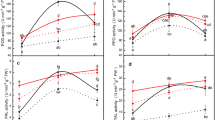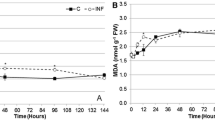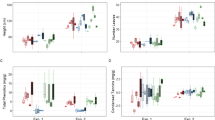Abstract
Aphids are considered one of the most damaging pests in agriculture. Plants respond to aphid attack with the production of toxic, repellent and/or antinutritive metabolites, including phenolic compounds. In this study, we examined the free phenolic acid composition of pepper (Capsicum annuum L.) leaves in response to green peach aphid (Myzus persicae Sulzer) feeding in different time course experiments. When plants were infested with an initial low density of aphids (20 aphids/plant), few significant changes were shown in leave phenolic content suggesting a very slight response from plants. However, with a high density of aphids (200 aphids/plant), several phenolics, especially the cinnamic acids (C6-C3): caffeic acid, p-coumaric acid, and sinapic acid, and also the p-hydroxybenzoic acid, salicylic acid, accumulated at specific times. Conversely, another hydroxy-benzoic acid: protocatechuic acid strongly decreased in response to infestation. The possible role of the observed changes in plant defence responses or in aphid counter-defence is discussed.


Similar content being viewed by others
References
Arimboor R, Kumar KS, Arumughan C (2008) Simultaneous estimation of phenolic acids in sea buckthorn (Hippophaë rhamnoides) using RP-HPLC with DAD. J Pharm Biomed Anal 47:31–38
Bass C, Puinean AM, Zimmer CT, Denholm I, Field LM, Foster SP, Gutbrod O, Nauen R, Slater R, Williamson MS (2014) The evolution of insecticide resistance in the peach potato aphid, Myzus persicae. Insect Biochem Mol Biol 51:41–51
Cheynier V, Comte G, Davies KM, Lattanzio V, Martens S (2013) Plant phenolics: recent advances on their biosynthesis, genetics, and ecophysiology. Plant Physiol Biochem 72:1–20
Chrzanowski G, Leszczynski B, Czerniewicz P, Sytykiewicz H, Matok H, Krzyzanowski R, Sempruch C (2012) Effect of phenolic acids from black currant, sour cherry and walnut on grain aphid (Sitobion avenae F.) development. Crop Prot 35:71–77
Ciepiela AP, Chrzanowski G (1999) Content of phenolic compounds in winter triticale of different resistance to grain aphid. Ann Agr Sci Ser 28:23–27
Ciepiela AP, Chrzanowski G (2001) Accumulation of ferulic, gallic, o-coumaric and salicylic acid in winter triticale of different resistance to grain aphid (Sitobion avenae F., Homoptera: Aphididae). Aphids Other Homopterous Insects 8:205–212
Coppola V, Coppola M, Rocco M, Digilio MC, D’Ambrosio C, Renzone G, Martinelli R, Scaloni A, Pennacchio F, Rao R, Corrado G (2013) Transcriptomic and proteomic analysis of a compatible tomato-aphid interaction reveals a predominant salicylic acid-dependent plant response. BMC Genomics 14:515. https://doi.org/10.1186/1471-2164-14-515
Czerniewicz P, Leszczynski B, Chrzanowski G, Sempruch C, Sytykiewicz H (2011) Effects of host plant phenolics on spring migration of bird cherry-oat aphid (Rhopalosiphum padi L.). Allelopath J 27:309–316
Czerniewicz P, Chrzanowski G, Sytykiewicz H, Sprawka I, Leszczynski B (2016) Aphidicidal and deterrent activity of phenolic acid extracts from some herbal plants towards Myzus persicae Sulz. and Rhopalosiphum padi L. Fresen Environ Bull 25:5714–5721
Czerniewicz P, Sytykiewicz H, Durak R, Borowiak-Sobkowiak B, Chrzanowski G (2017) Role of phenolic compounds during antioxidative responses of winter triticale to aphid and beetle attack. Plant Physiol Biochem 118:529–540
Dar SA, Rather BA, Wani AR, Ganie MA (2017) Resistance against insect pests by plant phenolics and their derivative compounds. Chem Sci Rev Lett 6:1941–1949
Delaney TP, Uknes S, Vernooij B, Friedrich L, Weymann K, Negrotto D, Gaffney T, Gut-Rella M, Kessmann H, Ward E, Ryals J (1994) A central role of salicylic acid in plant disease resistance. Science 266:1247–1250
Dixit G, Praveen A, Tripathi T, Yadav VK, Verma PC (2017) Herbivore-responsive cotton phenolics and their impact on insect performance and biochemistry. J Asia Pac Entomol 20:341–351. https://doi.org/10.1016/j.aspen.2017.02.002
Dreyer DL, Jones KC (1981) Feeding deterrency of flavonoids and related phenolics towards Schizaphis graminum and Myzus persicae: aphid feeding deterrents in wheat. Phytochemistry 20:2489–2493
Florencio-Ortiz V, Sellés-Marchart S, Zubcoff-Vallejo J, Jander G, Casas JL (2018a) Changes in the free amino acid composition of Capsicum annuum (pepper) leaves in response to Myzus persicae (green peach aphid) infestation. A comparison with water stress. PLoS ONE 13(6):e0198093. https://doi.org/10.1371/journal.pone.0198093
Florencio-Ortiz V, Novák O, Casas JL (2018b) Local and systemic hormonal responses in pepper (Capsicum annuum L.) leaves under green peach aphid (Myzus persicae Sulzer) infestation. J Plant Physiol 231:356–363
Florencio-Ortiz V, Novák O, Casas JL (2020) Phytohormone responses in pepper (Capsicum annuum L.) leaves under a high density of aphid infestation. Physiol Plant 170:519–527
Florencio-Ortiz V, Sellés-Marchart S, Casas JL (2021) Proteome changes in pepper (Capsicum annuum L.) leaves induced by the green peach aphid (Myzus persicae Sulzer). BMC Plant Biol 21:12. https://doi.org/10.1186/s12870-020-02749-x
Gantner M, Najda A, Piesik D (2019) Effect of phenolic acid content on acceptance of hazel cultivars by filbert aphid. Plant Prot Sci. https://doi.org/10.17221/150/2017-PPS
Giordanengo P, Brunissen L, Rusterucci C, Vincent C, van Bel A, Dinant S, Girousse C, Faucher M, Bonnemain J-L (2010) Compatible plant aphid interactions: how aphids manipulate plant responses. C R Biol 333:516–523
Goławska S, Łukasik I (2012) Antifeedant activity of luteolin and genistein against the pea aphid, Acyrthosiphon pisum. Pest Sci 85:443–450
Guerrieri E, Digilio MC (2008) Aphid-plant interactions: a review. J Plant Interact 3:223–232
Gruz J, Novák O, Strnad M (2008) Rapid analysis of phenolic acids in beverages by UPLC–MS/MS. Food Chem 111:789–794
Han Y, Wang Y, Bi J-L, Yang X-Q, Huang Y, Zhao X, Hu Y, Cai Q-N (2009) Constitutive and induced activities of defense-related enzymes in aphid-resistant and aphid-susceptible cultivars of wheat. J Chem Ecol 35:176–182
He J, Chen F, Chen S, Lv G, Deng Y, Fang W, Liu Z, Guan Z, He C (2011) Chrysanthemum leaf epidermal surface morphology and antioxidant and defense enzyme activity in response to aphid infestation. J Plant Physiol 68:687–693
Howe GA, Jander G (2008) Plant immunity to insect herbivores. Annu Rev Plant Biol 59:41–66
Islam MT, Lee B-R, La VH, Lee H, Jung W-J, Bae D-W, Kim T-H (2019) p-Coumaric acid induces jasmonic acid-mediated phenolic accumulation and resistance to black rot disease in Brassica napus. Physiol Mol Plant Pathol 106:270–275
Lattanzio V, Arpaia S, Cardinali A, Di Venere D, Linsalata V (2000) Role of endogenous flavonoids in resistance mechanism of Vigna to aphids. J Agric Food Chem 48:5316–5320
Lattanzio V, Lattanzio VMT, Cardinali A (2006) Role of polyphenols in the resistance mechanisms of plants against fungal pathogens and insects. In: Imperato F (ed) Phytochemistry: advances in research. Research Signpost, Kerala, pp 24–67
Leiss KA, Maltese F, Choi YH, Verpoorte R, Klinkhamer PGL (2009) Identification of chlorogenic acid as a resistance factor for thrips in Chrysanthemum. Plant Physiol 150:1567–1575
Leszczyński B, Warchoł J, Niraz S (1985) The influence of phenolic compounds on the preference of winter wheat cultivars by cereal aphids. Insect Sci Appl 6:157–158
Li Q, Xie Q-G, Smith-Becker J, Navarre DA, Kaloshian I (2006) Mi-1-mediated aphid resistance involves salicylic acid and mitogen-activated protein kinase signaling cascades. Mol Plant-Microbe Interact 19:655–664
Louis J, Shah J (2013) Arabidopsis thaliana-Myzus persicae interaction: shaping the understanding of plant defense against phloem-feeding aphids. Front Plant Sci 1:213. https://doi.org/10.3389/fpls.2013.00213
Maffei ME, Mithöfer A, Boland W (2007a) Before gene expression: early events in plant–insect interaction. Trends Plant Sci 12:310–316
Maffei ME, Mithöfer A, Boland W (2007b) Insects feeding on plants: rapid signals and responses preceding the induction of phytochemical release. Phytochemistry 68:2946–2959
Mai VC, Bednarski W, Borowiak-Sobkowiak B, Wilkaniec B, Samardakiewicz S, Morkunas I (2013) Oxidative stress in pea seedling leaves in response to Acyrthosiphon pisum infestation. Phytochemistry 93:49–62
Martinez de Ilarduya O, Xie Q, Kaloshian I (2003) Aphid-induced defense responses in Mi-1-mediated compatible and incompatible tomato interactions. Mol Plant-Microbe Interact 16:699–708
Mithöfer A, Boland W (2012) Plant defense against herbivores: chemical aspects. Annu Rev Plant Biol 63:431–450
Mohase L, Van der Westhuizen AJ (2002) Salicylic acid is involved in resistance responses in the Russian wheat aphid-wheat interaction. J Plant Physiol 159:585–590
Moran PJ, Thompson GA (2001) Molecular responses to aphid feeding in Arabidopsis in relation to plant defense pathways. Plant Physiol 125:1074–1085
Morkunas I, Mai VC, Gabrys B (2011) Phytohormonal signaling in plant responses to aphid feeding. Acta Physiol Plant 33:2057–2073
Niu L, Pan L, Zeng W, Lu Z, Cui G, Fan M, Xu Q, Wang Z, Li G (2018) Dynamic transcriptomes of resistant and susceptible peach lines after infestation by green peach aphids (Myzus persicae Sülzer) reveal defence responses controlled by the Rm3 locus. BMC Genomics 19:846. https://doi.org/10.1186/s12864-018-5215-7
Qin QJ, Shi XY, Liang P, Gao XW (2005) Induction of phenylalanine ammonia-lyase and lipoxygenase in cotton seedlings by mechanical wounding and aphid infestation. Prog Nat Sci 5:419–423
Reis-Giada ML (2013) Food Phenolic compounds: main classes, sources and their antioxidant power. In: Morales-Gonzalez JA (ed) Oxidative stress and chronic degenerative diseases. IntechOpen, London
Riaz U, Kharal MA, Murtaza G, Zaman Q, Javaid S, Malik HA, Aziz H, Abbas Z (2019) Prospective roles and mechanisms of caffeic acid in counter plant stress: a mini review. Pak J Agric Res 32(1):8–19
Russell W, Duthie C (2011) Plant secondary metabolites and gut health: the case for phenolic acids. Proc Nutr Soc 70:389–396
Saguez J, Giordanengo P, Vicent C (2013) Aphids as major potato pest. In: Giordanengo P, Vicent C, Alyokhin A (eds) Insect pests of potato. Elsevier, Oxford, pp 31–63
Simon JC, Peccoud J (2018) Rapid evolution of aphid pests in agricultural environments. Curr Opin Insect Sci 26:17–24
Smith CM, Boyko EV (2007) The molecular bases of plant resistance and defense responses to aphid feeding: current status. Entomol Exp Appl 122:1–16
Sorensen JT (2009) Aphids. In: Resh VH, Cardé RT (eds) Encyclopedia of Insects. Elsevier, Oxford, pp 27–31
van Bel AJE, Will T (2016) Functional evaluation of proteins in watery and gel saliva of aphids. Front Plant Sci 7:1840. https://doi.org/10.3389/fpls.2016.01840
Vermerris W, Nicholson R (2006) Phenolic compound biochemistry. Springer, Dordrecht
War AR, Paulraj MG, Ahmad T, Buhroo AA, Hussain B, Ignacimuthu S, Sharma HC (2012) Mechanisms of plant defense against insect herbivores. Plant Signal Behav 7:1306–1320
War AR, Paulraj MG, Ignacimuthu S, Sharma HC (2013) Defensive responses in groundnut against chewing and sap-sucking insects. J Plant Growth Regul 32:259–272
Wójcicka A (2010) Cereal phenolic compounds as biopesticides of cereal aphids. Pol J Environ Stud 19:1337–1343
Yan H-Y, Guo H-G, Sun Y-C, Ge F (2018) Plant phenolics mediated bottom-up effects of elevated CO2 on Acyrthosiphonpisum and its parasitoid Aphidius avenae. Insect Sci 27:170–184. https://doi.org/10.1111/1744-7917.12627
Zhang M, Wang D, Gao X, Yue Z, Zhou H (2020) Exogenous caffeic acid and epicatechin enhance resistance against Botrytis cinerea through activation of the phenylpropanoid pathway in apples. Sci Hortic 268:109348. https://doi.org/10.1016/j.scienta.2020.109348
Funding
This work was supported by Ministerio de Economía y Competitividad (Project CGL2016-79054-R), by University of Alicante grant (UAFPU2013-5793) to VFO, by the Czech Science Foundation (No. 19-00973S) and by ERDF project “Development of pre-applied research in nanotechnogy and biotechnology” (No. CZ.02.1.01/0.0/0.0/17_048/0007323). The present work is part of VFO PhD Thesis.
Author information
Authors and Affiliations
Corresponding author
Ethics declarations
Conflict of interest
The authors declare that they have no competing interest.
Additional information
Publisher's Note
Springer Nature remains neutral with regard to jurisdictional claims in published maps and institutional affiliations.
Rights and permissions
About this article
Cite this article
Florencio-Ortiz, V., Gruz, J. & Casas, J.L. Changes in the free phenolic acid composition of pepper (Capsicum annuum L.) leaves in response to green peach aphid (Myzus persicae Sulzer) infestation. Arthropod-Plant Interactions 15, 329–336 (2021). https://doi.org/10.1007/s11829-021-09820-w
Received:
Accepted:
Published:
Issue Date:
DOI: https://doi.org/10.1007/s11829-021-09820-w




